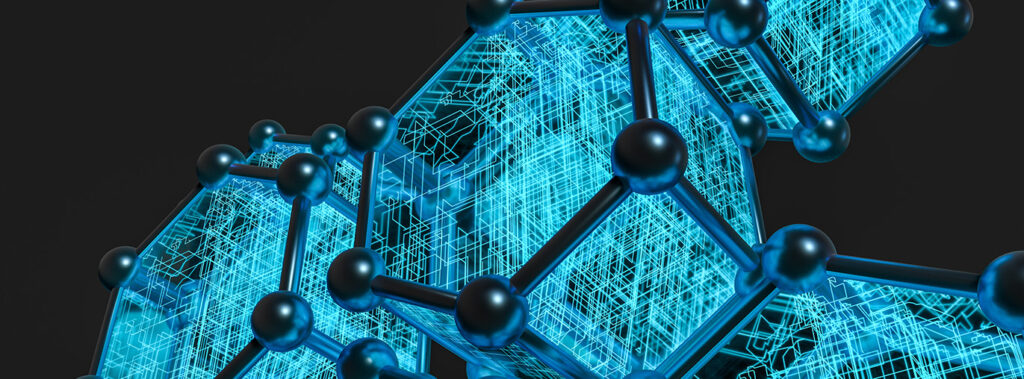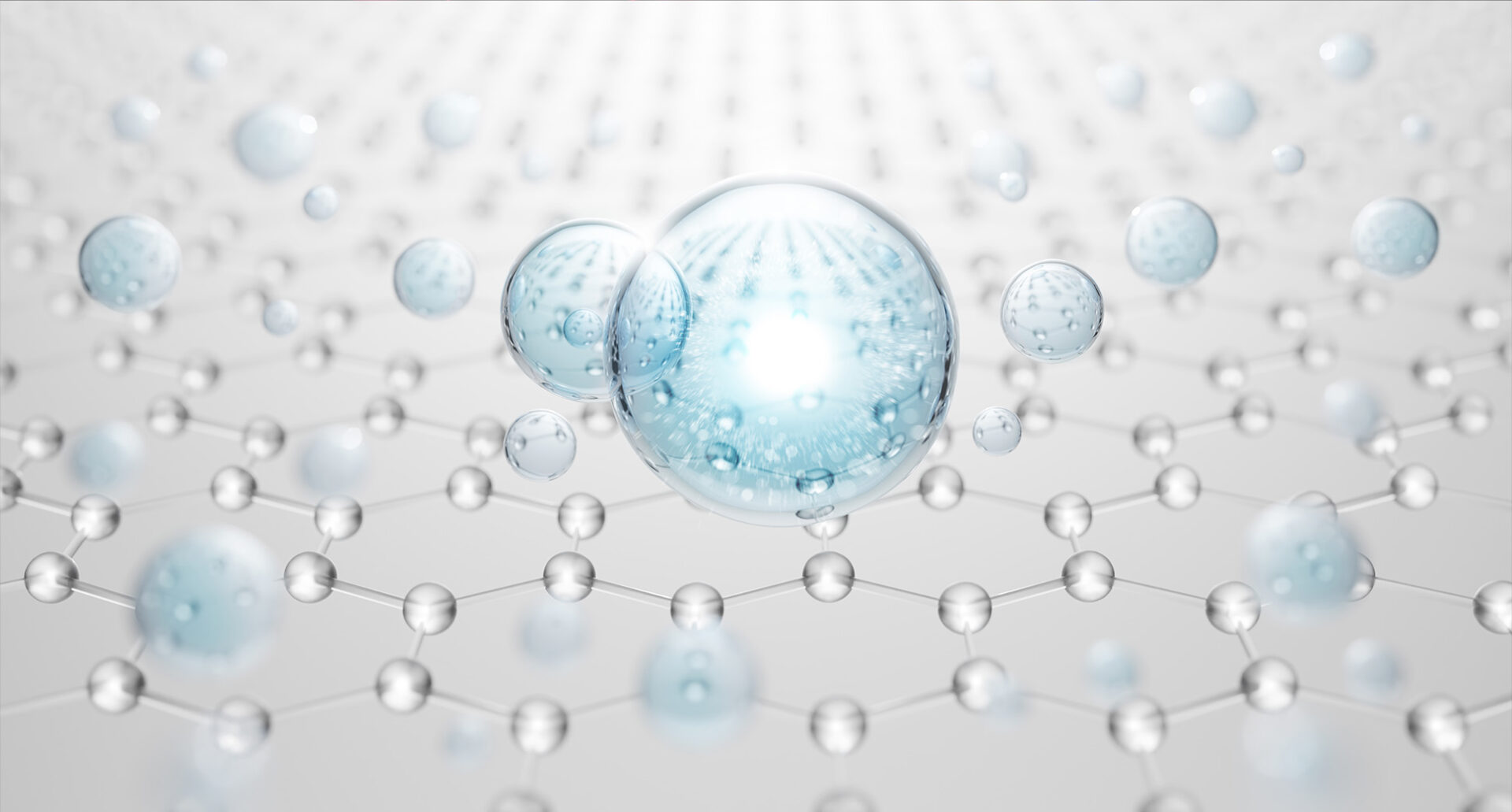Hydrogels and Graphene:
The Technological Fusion Revolutionizing Materials Science
Hydrogels are polymeric networks with a hydrophilic structure that allows them to retain large amounts of water in their three-dimensional networks. From their first references in 1900 to the advancements by Wichterle and Lim in the 1960s, hydrogel technology has evolved to become a vital solution in fields such as medicine (for controlled drug or bioactive agent delivery), environmental remediation (for contaminant adsorption or soil restoration), agriculture (for water retention or soil conditioning), food industry (from texturizing agents to smart packaging), and even energy storage, among others.
“In 1900, the term ‘hydrogel’ first appeared in scientific literature to describe a colloidal gel of inorganic salts.”
Hydrogels may be chemically crosslinked through covalent bonds, physically through non-covalent interactions, or via a combination of both. They are classified into natural (including proteins such as collagen and gelatin, and polysaccharides such as starch, alginate, and agarose), synthetic (produced through chemical polymerization methods), and hybrid hydrogels. Synthetic materials have largely replaced natural ones due to better water absorption, longer lifespan, and a broader variety of raw materials.
“The water absorption capacity of hydrogels is due to hydrophilic functional groups attached to their polymer structure, while their resistance to dissolution results from crosslinks between the network chains.”
Hydrogels are mainly known and used for their excellent water absorption capabilities without altering their structure. However, their low mechanical strength and sensitivity to external stimuli such as temperature, light, or electric fields can either enhance or limit their performance in dynamic environments. Some examples include:
Temperature Sensitivity: These hydrogels expand or contract in response to heat or cold, enabling them to release contaminants, drugs, or bioactive agents—ideal for wastewater treatment or medical therapies. Their challenges include long-term stability and precise temperature responsiveness.
Photosensitivity: The integration of photoactive agents into their polymer networks can improve contaminant degradation, activate and release specific drugs, or enhance cellular growth conditions in tissue engineering. However, continuous UV exposure may lead to photodegradation of the material.
Electric Field Sensitivity: Electroactive hydrogels incorporate ionic groups that move and alter the hydrogel’s structure under an electric field, modifying its permeability to allow or block the passage of substances. This is useful for wastewater treatment and controlled water or nutrient release in agriculture. High costs and limited durability remain key challenges.
pH Sensitivity: This is achieved by incorporating ionizable functional groups (carboxyl or amino), which gain or lose protons based on environmental pH, triggering structural changes that allow water absorption or release.
How Does Nanotechnology Enhance Hydrogel Performance?
Nanotechnology—the interdisciplinary field focused on manipulating and manufacturing materials at the atomic and molecular scale (1–100 nanometers)—has made significant contributions to hydrogels, particularly in improving mechanical strength and developing smart functionalities for biomedical and environmental applications.
“To understand the nanoscale, consider that the average thickness of a human hair is approximately 60,000 nm, while a nanometer is one-millionth of a millimeter.”
What Added Value Does Graphene Bring to Hydrogels?
Graphene is a nanometric, two-dimensional (2D) carbon sheet one atom thick, with a structure similar to a benzene ring. It has attracted significant research interest due to its exceptional properties: thermal conductivity, mechanical strength, flexibility, and biocompatibility, among others, which can be transferred to hydrogel matrices.
1. Mechanical Strength:
One of the key limitations of hydrogels is their low mechanical resistance, making them unsuitable for high-stress environments. Graphene can significantly reinforce hydrogel structure, improving durability and mechanical stability.
2. Thermal Stability:
Hydrogels are sensitive to temperature changes, which can affect their performance. Graphene can enhance their thermal stability, maintaining functional properties across wider temperature ranges.
3. Antimicrobial Protection and Biocompatibility:
While hydrogels are generally biocompatible, scientific evidence shows that adding graphene improves their stability and compatibility. Its intrinsic antimicrobial properties also make hydrogels safer for infection-sensitive applications.

4. Electrical Responsiveness:
Graphene’s ability to transmit electrical signals supports cell communication in electrically active tissues (e.g., nerve, muscle, heart). It also enables controlled drug release under voltage stimulation, while minimizing overheating during electrical activation.
Although there are no graphene-based hydrogels commercially available yet, many experimental nanotechnological developments around the world are laying the groundwork for future applications, including:
- Spain (2025): A study by the Spanish National Research Council and the National Hospital for Paraplegics used a reduced graphene oxide (rGO) foam scaffold to reconnect severed spinal cords in rats, promoting neuronal reconnection and vascular regeneration.
- Argentina (2025): The University of Buenos Aires, CONICET, and INTI developed hydrogels resistant to hydration-dehydration cycles for nanofiltration of viruses, bacteria, fungi, and heavy metals from water.
- USA (2023): A study published in Environmental Science & Technology demonstrated that graphene-based hydrogels could remove up to 95% of lead ions from aqueous solutions.
- China (2022): Biomaterials Translational published a study on a hyaluronic acid–graphene oxide hydrogel combined with Senexin A for treating vascular occlusive diseases, achieving sustained release over 21 days and good biocompatibility.
- USA (2022): In Applied Materials & Interfaces, researchers reported a graphene hydrogel scaffold that promoted cartilage regeneration with type II collagen expression and stable cellular growth.
- Spain (2018): Researchers at the University of the Basque Country developed a starch–graphene hydrogel for flexible brain implant electrodes. The graphene was stabilized in water using sage extract, which also added antibacterial and electrical properties.
- USA (2017): A porous graphene oxide hydrogel developed for water purification showed enhanced contaminant adsorption due to improved stability, nanotransport channels, and hydrogen bonding.
- USA (2017): A soft, injectable hydrogel made from PEGDA–melamine and GO improved cardiac function in rats with myocardial infarction, reducing infarct size and fibrosis while promoting neovascularization.
Conclusion
Graphene-based hydrogels, and those incorporating its derivatives, offer significant structural and functional improvements. Their development represents a leap toward smarter and more adaptive systems in biomedicine, agriculture, and environmental remediation. However, like any emerging technology, widespread adoption will require overcoming regulatory and large-scale manufacturing challenges.
Written by: EF/ DHS
References
- Visan, A. I.; Negut, I. Environmental and Wastewater Treatment Applications of StimulusResponsive Hydrogels. Gels 2025, 11 (1), 72.
- Yu, K.; Wang, D.; Wang, Q. Tough and SelfHealable Nanocomposite Hydrogels for Repeatable Water Treatment. Polymers 2018, 10, 880.
- Lim, S. L.; Tang, W. N. H.; Ooi, C. W.; Chan, E.S.; Tey, B. T. Rapid swelling and deswelling of semiinterpenetrating network poly(acrylic acid)/poly(aspartic acid) hydrogels prepared by freezing polymerization. J. Appl. Polym. Sci. 2016, 133, 9.
- Yuan, Z.; Wang, Y.; Han, X.; Chen, D. The adsorption behaviors of the multiple stimulusresponsive poly(ethylene glycol)based hydrogels for removal of RhB dye. J. Appl. Polym. Sci. 2015, 132, 42244.
- Thakur, S.; Arotiba, O. Synthesis, characterization and adsorption studies of an acrylic acidgrafted sodium alginatebased TiO₂ hydrogel nanocomposite. Adsorpt. Sci. Technol. 2018, 36, 458–477.
- Eraković, Z.; Stefanović, D. Purification of contaminated wastewater with the help of graphene composites with hydrogels. Facta Univ. Ser. Work. Living Environ. Prot. 2022, 19, 27–**.
- Wu, R.; Tian, L.; Wang, W.; Man, X. Bifunctional cellulose derivatives for the removal of heavymetal ions and phenols: Synthesis and adsorption studies. J. Appl. Polym. Sci. 2015, 132, 41830.
- Zheng, Y.; Zhu, Y.; Wang, F.; Wang, A. GelatinGrafted Granular Composite Hydrogel for Selective Removal of Malachite Green. Water, Air, Soil Pollut. 2015, 226, 354.
- Malik, R.; Saxena, R.; Warkar, S. G. Organic Hybrid Hydrogels: A Sustenance Technique in WasteWater Treatment. ChemistrySelect 2023, 8, e202203670.
- Berg, J.; Seiffert, S. Composite hydrogels based on calcium alginate and polyethyleneimine for wastewater treatment. J. Polym. Sci. 2023, 61, 2203.
- Singh, R.; Datta, B. Advances in Biomedical and Environmental Applications of Magnetic Hydrogels. ACS Appl. Polym. Mater. 2023, 5, 5474.
- Tang, S. C. N.; Yan, D. Y. S.; Lo, I. M. C. Sustainable Wastewater Treatment Using Microsized Magnetic Hydrogel with Magnetic Separation Technology. Ind. Eng. Chem. Res. 2014, 53, 15718.
- Wahid, F.; Zhao, X.J.; Jia, S.R.; Bai, H.; Zhong, C. Nanocomposite hydrogels as multifunctional systems for biomedical applications: Current state and perspectives. Composites Part B: Engineering 2020, 200, 108208.
- Bao, R.; Tan, B.; Liang, S.; Zhang, N.; Wang, W.; Liu, W. A ππ conjugationcontaining soft and conductive injectable polymer hydrogel highly efficiently rebuilds cardiac function after myocardial infarction. Biomaterials 2017, 122, 63.
- Maturavongsadit, P.; Wu, W.; Fan, J.; Roninson, I. B.; Cui, T.; Wang, Q. Grapheneincorporated hyaluronic acidbased hydrogel as a controlled Senexin A delivery system. Biomater. Transl. 2022, 3 (2), 152–161.
- Lyu, C.; Cheng, C.; He, Y.; Qiu, L.; He, Z.; Zou, D.; Li, D.; Lu, J. Graphene hydrogel as a porous scaffold for cartilage regeneration. ACS Appl. Mater. Interfaces 2022, 14 (49), 54431.
- T. Sawyer, Principles of Nanotechnology, Murphy & Moore Publishing, 2022.

